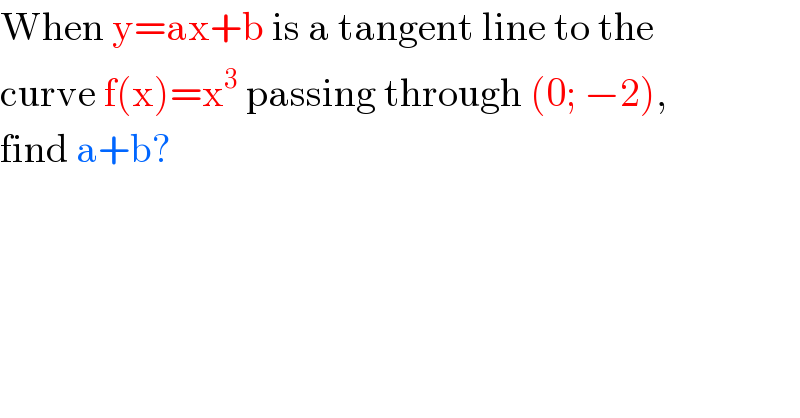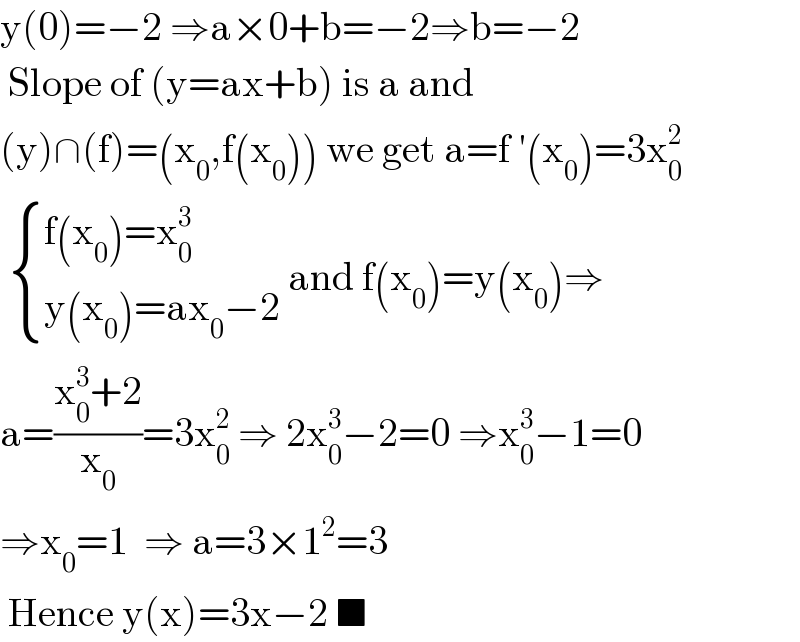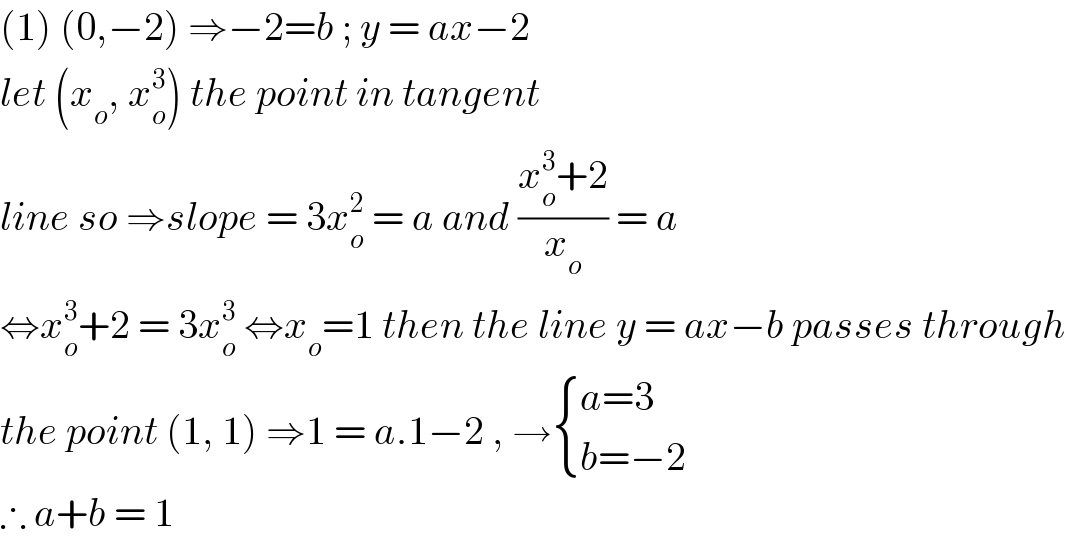
Question Number 103659 by abony1303 last updated on 16/Jul/20

$$\mathrm{When}\:\mathrm{y}=\mathrm{ax}+\mathrm{b}\:\mathrm{is}\:\mathrm{a}\:\mathrm{tangent}\:\mathrm{line}\:\mathrm{to}\:\mathrm{the} \\ $$$$\mathrm{curve}\:\mathrm{f}\left(\mathrm{x}\right)=\mathrm{x}^{\mathrm{3}} \:\mathrm{passing}\:\mathrm{through}\:\left(\mathrm{0};\:−\mathrm{2}\right), \\ $$$$\mathrm{find}\:\mathrm{a}+\mathrm{b}? \\ $$
Commented by abony1303 last updated on 16/Jul/20

$$\mathrm{pls}\:\mathrm{help} \\ $$
Answered by Aziztisffola last updated on 16/Jul/20

$$\mathrm{y}\left(\mathrm{0}\right)=−\mathrm{2}\:\Rightarrow\mathrm{a}×\mathrm{0}+\mathrm{b}=−\mathrm{2}\Rightarrow\mathrm{b}=−\mathrm{2} \\ $$$$\:\mathrm{Slope}\:\mathrm{of}\:\left(\mathrm{y}=\mathrm{ax}+\mathrm{b}\right)\:\mathrm{is}\:\mathrm{a}\:\mathrm{and} \\ $$$$\left(\mathrm{y}\right)\cap\left(\mathrm{f}\right)=\left(\mathrm{x}_{\mathrm{0}} ,\mathrm{f}\left(\mathrm{x}_{\mathrm{0}} \right)\right)\:\mathrm{we}\:\mathrm{get}\:\mathrm{a}=\mathrm{f}\:'\left(\mathrm{x}_{\mathrm{0}} \right)=\mathrm{3x}_{\mathrm{0}} ^{\mathrm{2}} \\ $$$$\:\begin{cases}{\mathrm{f}\left(\mathrm{x}_{\mathrm{0}} \right)=\mathrm{x}_{\mathrm{0}} ^{\mathrm{3}} }\\{\mathrm{y}\left(\mathrm{x}_{\mathrm{0}} \right)=\mathrm{ax}_{\mathrm{0}} −\mathrm{2}}\end{cases}\:\mathrm{and}\:\mathrm{f}\left(\mathrm{x}_{\mathrm{0}} \right)=\mathrm{y}\left(\mathrm{x}_{\mathrm{0}} \right)\Rightarrow \\ $$$$\mathrm{a}=\frac{\mathrm{x}_{\mathrm{0}} ^{\mathrm{3}} +\mathrm{2}}{\mathrm{x}_{\mathrm{0}} }=\mathrm{3x}_{\mathrm{0}} ^{\mathrm{2}} \:\Rightarrow\:\mathrm{2x}_{\mathrm{0}} ^{\mathrm{3}} −\mathrm{2}=\mathrm{0}\:\Rightarrow\mathrm{x}_{\mathrm{0}} ^{\mathrm{3}} −\mathrm{1}=\mathrm{0} \\ $$$$\Rightarrow\mathrm{x}_{\mathrm{0}} =\mathrm{1}\:\:\Rightarrow\:\mathrm{a}=\mathrm{3}×\mathrm{1}^{\mathrm{2}} =\mathrm{3} \\ $$$$\:\mathrm{Hence}\:\mathrm{y}\left(\mathrm{x}\right)=\mathrm{3x}−\mathrm{2}\:\blacksquare \\ $$
Answered by bemath last updated on 16/Jul/20

$$\left(\mathrm{1}\right)\:\left(\mathrm{0},−\mathrm{2}\right)\:\Rightarrow−\mathrm{2}={b}\:;\:{y}\:=\:{ax}−\mathrm{2} \\ $$$${let}\:\left({x}_{{o}} ,\:{x}_{{o}} ^{\mathrm{3}} \right)\:{the}\:{point}\:{in}\:{tangent} \\ $$$${line}\:{so}\:\Rightarrow{slope}\:=\:\mathrm{3}{x}_{{o}} ^{\mathrm{2}} \:=\:{a}\:{and}\:\frac{{x}_{{o}} ^{\mathrm{3}} +\mathrm{2}}{{x}_{{o}} }\:=\:{a} \\ $$$$\Leftrightarrow{x}_{{o}} ^{\mathrm{3}} +\mathrm{2}\:=\:\mathrm{3}{x}_{{o}} ^{\mathrm{3}} \:\Leftrightarrow{x}_{{o}} =\mathrm{1}\:{then}\:{the}\:{line}\:{y}\:=\:{ax}−{b}\:{passes}\:{through}\: \\ $$$${the}\:{point}\:\left(\mathrm{1},\:\mathrm{1}\right)\:\Rightarrow\mathrm{1}\:=\:{a}.\mathrm{1}−\mathrm{2}\:,\:\rightarrow\begin{cases}{{a}=\mathrm{3}}\\{{b}=−\mathrm{2}}\end{cases} \\ $$$$\therefore\:{a}+{b}\:=\:\mathrm{1}\: \\ $$
